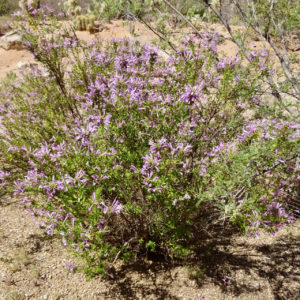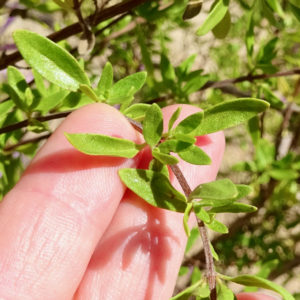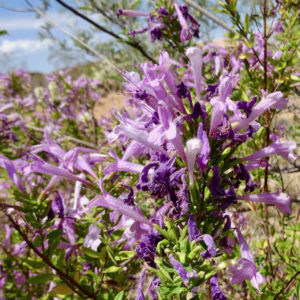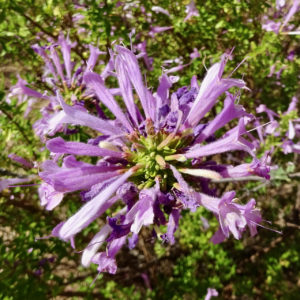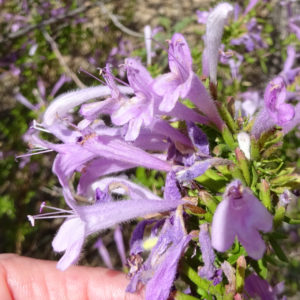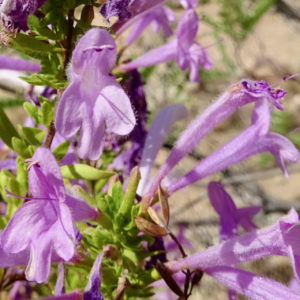Lavender Spice
Poliomintha maderensis
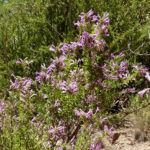
About the Plant
Note: The following discussion is based on the plants growing in my yard. Thus, plants in other environments and locations may perform differently.
Lavender Spice™ is a selection of a Poliomintha maderensis, a native of Coahuila, Mexico. In the past, this species was confused with Poliomintha incana, a southwest US native with smaller flowers or with Poliomintha longiflora, a Mexican native with long, orange flowers. To add more confusion, all three have highly scented foliage and may be given common names that include "oregano" - Mexican oregano, southwest oregano, desert oregano, etc. The use of the name "Mexican oregano" is especially confusing because it is commonly used for Lippia graveolens, a plant whose appearance will remind you of lantana. When purchasing any of these plants, it is best to see the plant in flower in addition to confirming the scientific name.
Lavender Spice™ is a fragrant 3-4 foot shrub with small, evergreen leaves and brittle stems. Flowering begins in late spring and can continue through summer into fall with irrigation. The tubular, lavender flowers start out almost white and darken as they age, so several colors appear on the plant at the same time. The flowers are visited by butterflies and moths and most enthusiastically by hummingbirds who will battle for feeding rights.
Lavender Spice™ prefers well-drained soil and full sun, but will tolerate some shade. Place it where the flowers (and hummingbirds) are easily visible but away from high traffic areas. The branches break easily. At the end of the season, the flowers of Lavender Spice™ will turn brown but may stay on the plant. Simply run your hands from the bottom to the top of the flower cluster to brush off the brown flowers. Gloves recommended, as the strong scent lingers on the skin.
Prune carefully. It is always OK to cut off dead branches. References suggest pruning late winter before growth begins since the plant flowers on new growth. However, in my hands, the plants sulked when this was done and flowering was delayed 2 or 3 or perhaps even 4 years. Do not cut back all of your plants at the same time if you want to make sure you have flowers every year.
Notes:
- Poliomintha maderensis leaves can be used as a substitute for oregano, though the flavor is stronger and a bit spicy. As noted above, it can be confused with Lippia graveolens, the species most commonly used as "Mexican oregano".
- The leaves of Lavender Spice™ have a very strong scent that is released whenever the leaves are brushed. Test your tolerance to this scent and locate these plants accordingly.
Wildlife value: Hummingbirds love the flowers of this plant. Butterflies and moths may be attracted to the flowers as well.
More Information
Horticultural info from Texas A&M
In books:
Perennials for the Southwest by Mary Irish, page 208
ID Characteristics
Lavender Spice™ is an evergreen shrub with thin, brittle stems. It grows to 3-4 feet high and about as wide.
The leaves of Lavender Spice™ are opposite. Each leaf is ovate-elliptic, 1/2 to 3/4 inch long with a very short petiole, releasing a strong scent when bruised.
Flowers are formed on the tips of new growth. The leaves become smaller and more closely spaced. The flowers are axial, growing from the base each leaf. The cluster of flowers elongates as the stem grows. The overall effect is quite showy.
The flowers are formed all around the stem. New flowers appear at the top of the stem, often emerging white or light-colored, then darkening as they mature.
The flowers are lavender, about 1.5 inches long, narrow at the base made of 5 fused petals. The flower gradually widens then flares at the tip. The calyx is green, occasionally with browned tips, sometimes appearing ribbed, about 1/4 inch long.
The 5 fused petals separate near the tip of the flower. Two upper petals stay fused while the lobes of the lower 3 petals are easily seen. The stamen and pistil are also lavender and blend in with the petals.
In cultivation Lavender Spice™ very seldom forms fruit. In fall, the dried, brown flowers often stay on the plant.
